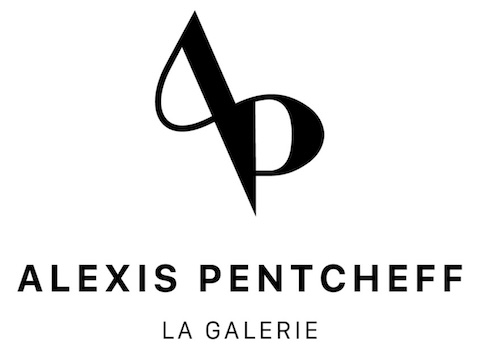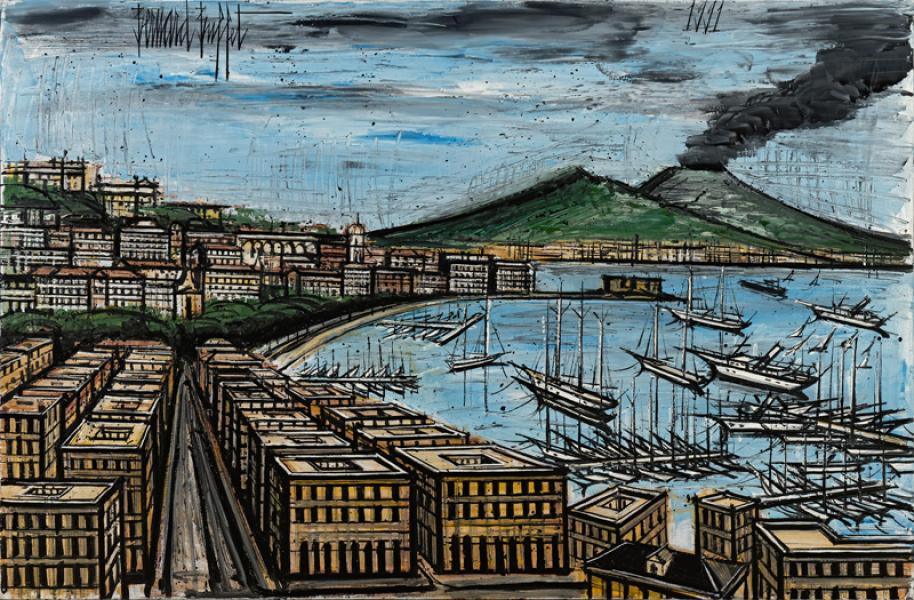La baie de Naples et le Vésuve, 1991
Oil on canvas, signed upper left and dated 1991 upper right.
130 x 195 cm
Provenance :
Private collection, France
Exhibitions :
Bernard Buffet, Souvenirs d'Italie, Galerie Maurice Garnier, Paris, November-December 1991, reproduced in catalog no. 19, p.47.
Bibliography:
Yann Le Pichon, Bernard Buffet, Galerie Maurice Garnier, Paris, 1990-2007, reproduced under no. 1119, vol.3, pp. 344-345.
IMMINENT ERUPTION
Naples, 1991. In his signature incisive calligraphy, the date of the painting is inscribed by Buffet above the crater of Mount Vesuvius, from which an ominous grey column rises. However, on this date, the volcano did not seem to be angry; since the end of the Second World War, Neapolitans had not seen this morbid plume rise above its summit. Here, the painter resurrects the memory of the last eruption, in March 1944, when a cloud of ash was blown into the atmosphere. In the midst of the American occupation, Vesuvius awoke. It had only been sleeping with one eye open, and for some thirty years, powerful volcanic activity had been building up at the crater's rim, eventually overflowing it. A column of ash rose nearly five kilometers into the air, and lava flows poured down the sides of the volcano. On the slopes of Vesuvius, the lava slowly made its way down the main road, while the black-clad inhabitants prayed on their knees.
The eruption caused material damage and a few casualties, but the Neapolitans' prayers seem to have been heard and the worst was avoided, unlike the ancient episode that destroyed the cities of Pompeii and Herculaneum in 79 AD. The repercussions of this catastrophe are still very much with us today, particularly in view of the spectacular results of the excavations undertaken at the sites. the spectacular results of the site excavations begun in the 18th century.
For Buffet, who is acutely aware of the omnipresence of death, imminent in the midst of life, the image of Vesuvius is undoubtedly even more so in the last decade of his life, when his painting of his life, when his painting is strongly influenced by this sentiment. The sky is speckled with ashes and black splashes, and hatching over the city and the volcano, using the sgraffito technique, evokes a still-contained violence.
The unpredictable, eruptive nature of the volcano is contrasted with the geometric alignment of the city around Corso Umberto, the main thoroughfare laid out after the cholera epidemic and which, for sanitary reasons, has opened up the port district since the end of the 19th century.
The view seems to be taken from higher up, probably from the Carthusian monastery of San Martino. The city, seemingly orderly and stable, reassuring in its reliable geometry, spreads out at the foot of the volcano. The presence of this column of smoke, however, assures us of its immense fragility due to its position. And the boats, with their spurs pointing like weapons towards the city, offer no salvation.
1991 was a busy year for the artist, who exhibited in Russia at the Pushkin Museum in Moscow and the Hermitage in St. Petersburg, as well as in Seoul at the Hyundai Museum. An exhibition at Galerie Maurice Garnier was devoted to "Souvenirs d'Italie", including this painting, which, somewhat ironically given its format, revives the tradition of Neapolitan gouaches.

